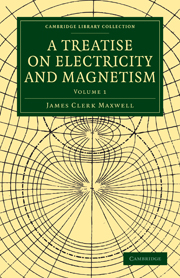Book contents
- Frontmatter
- PREFACE
- Contents
- ELECTRICITY AND MAGNETISM
- PRELIMINARY
- PART I ELECTROSTATICS
- PART II ELECTROKINEMATICS
- CHAPTER I THE ELECTRIC CURRENT
- CHAPTER II CONDUCTION AND RESISTANCE
- CHAPTER III ELECTROMOTIVE FORCE BETWEEN BODIES IN CONTACT
- CHAPTER IV ELECTROLYSIS
- CHAPTER V ELECTROLYTIC POLARIZATION
- CHAPTER VI MATHEMATICAL THEORY OF THE DISTRIBUTION OF ELECTRIC CURRENTS
- CHAPTER VII CONDUCTION IN THREE DIMENSIONS
- CHAPTER VIII RESISTANCE AND CONDUCTIVITY IN THREE DIMENSIONS
- CHAPTER IX CONDUCTION THROUGH HETEROGENEOUS MEDIA
- CHAPTER X CONDUCTION IN DIELECTRICS
- CHAPTER XI MEASUREMENT OF THE ELECTRIC RESISTANCE OF CONDUCTORS
- CHAPTER XII ELECTRIC RESISTANCE OF SUBSTANCES
- Plate section
CHAPTER IV - ELECTROLYSIS
Published online by Cambridge University Press: 05 July 2011
- Frontmatter
- PREFACE
- Contents
- ELECTRICITY AND MAGNETISM
- PRELIMINARY
- PART I ELECTROSTATICS
- PART II ELECTROKINEMATICS
- CHAPTER I THE ELECTRIC CURRENT
- CHAPTER II CONDUCTION AND RESISTANCE
- CHAPTER III ELECTROMOTIVE FORCE BETWEEN BODIES IN CONTACT
- CHAPTER IV ELECTROLYSIS
- CHAPTER V ELECTROLYTIC POLARIZATION
- CHAPTER VI MATHEMATICAL THEORY OF THE DISTRIBUTION OF ELECTRIC CURRENTS
- CHAPTER VII CONDUCTION IN THREE DIMENSIONS
- CHAPTER VIII RESISTANCE AND CONDUCTIVITY IN THREE DIMENSIONS
- CHAPTER IX CONDUCTION THROUGH HETEROGENEOUS MEDIA
- CHAPTER X CONDUCTION IN DIELECTRICS
- CHAPTER XI MEASUREMENT OF THE ELECTRIC RESISTANCE OF CONDUCTORS
- CHAPTER XII ELECTRIC RESISTANCE OF SUBSTANCES
- Plate section
Summary
Electrolytic Conduction
255.] I have already stated that when an electric current in any part of its circuit passes through certain compound substances called Electrolytes, the passage of the current is accompanied by a certain chemical process called Electrolysis, in which the substance is resolved into two components called Ions, of which one, called the Anion, or the electronegative component, appears at the Anode, or place where the current enters the electrolyte, and the other, called the Cation, appears at the Cathode, or the place where the current leaves the electrolyte.
The complete investigation of Electrolysis belongs quite as much to Chemistry as to Electricity. We shall consider it from an electrical point of view, without discussing its application to the theory of the constitution of chemical compounds.
Of all electrical phenomena electrolysis appears the most likely to furnish us with a real insight into the true nature of the electric current, because we find currents of ordinary matter and currents of electricity forming essential parts of the same phenomenon.
It is probably for this very reason that, in the present imperfectly formed state of our ideas about electricity, the theories of electrolysis are so unsatisfactory.
The fundamental law of electrolysis, which was established by Faraday, and confirmed by the experiments of Beetz, Hittorf, and others down to the present time, is as follows :—
The number of electrochemical equivalents of an electrolyte which are decomposed by the passage of an electric current during a given time is equal to the number of units of electricity which are transferred by the current in the same time.
- Type
- Chapter
- Information
- A Treatise on Electricity and Magnetism , pp. 307 - 317Publisher: Cambridge University PressPrint publication year: 2010First published in: 1873

